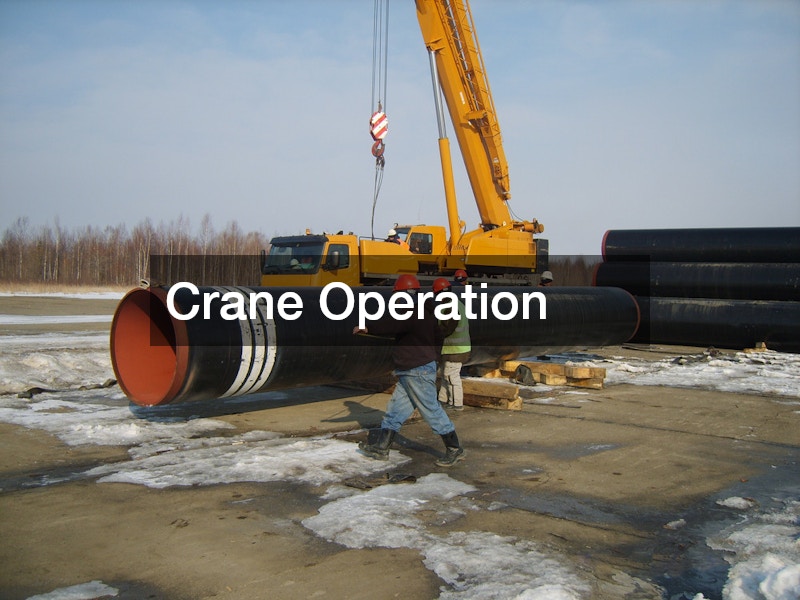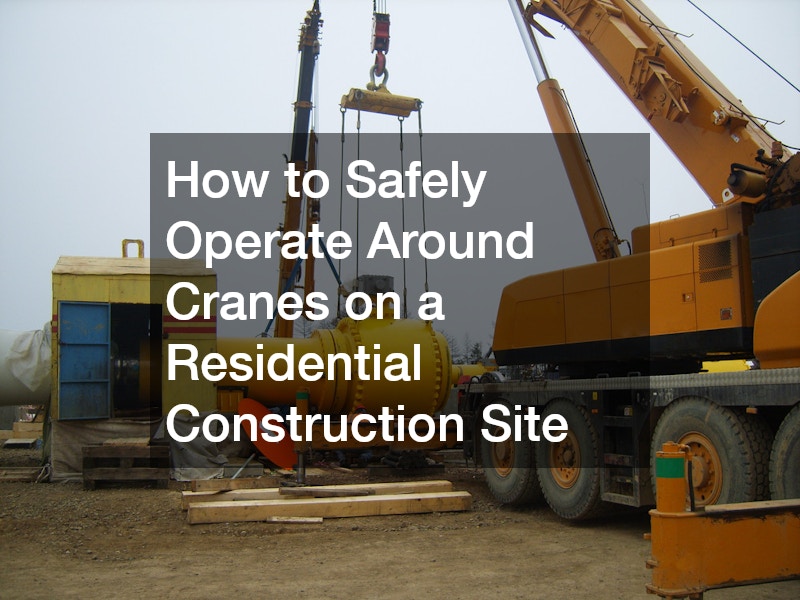- Always maintain a clear, designated crane operation zone.
- Proper communication between crane operators and ground crew is essential.
- Never walk under a suspended load—ever.
- Daily equipment inspections help prevent mechanical failures.
- Use PPE consistently, especially hard hats and high-visibility clothing.
- Understand and follow all site-specific crane safety protocols.
- Only trained and authorized personnel should be near crane operation areas.

Cranes are common on residential construction sites, especially for tasks like lifting trusses, HVAC units, and large structural materials. While they improve efficiency, they also pose serious safety risks. Improper crane use can lead to severe injuries, property damage, and even fatalities.
This guide will help homeowners, site managers, and crew members understand how to safely operate around cranes on smaller-scale construction sites. The focus is on actionable tips, OSHA-informed best practices, and practical insights gained from industry experience.
1. Know the Basics of Crane Operation
Before discussing safety, it’s essential to understand what crane operation entails on a residential construction site. Cranes are powerful machines designed to lift and move heavy loads, and even on small sites, they can create major risks if not handled properly. Unlike large-scale commercial projects, residential construction often uses more compact and mobile crane types that are adapted for tighter spaces and lighter structures. Knowing the differences between these crane types and their intended use helps everyone on-site work more safely and efficiently.
Basic Crane Types on Residential Sites
Each crane type has its own strengths and operational considerations. Understanding how they function is the first step toward ensuring safety and proper coordination.
- Mobile Cranes: These are commonly truck-mounted and offer excellent mobility. Mobile cranes are typically used when lifts need to be performed at different areas of the site quickly. They can be driven in and out of residential neighborhoods without the need for lengthy setup times. However, mobile cranes must be set up on stable ground and properly leveled to prevent tipping.
- Knuckle Boom Cranes (Articulating Cranes): Ideal for tight or restricted spaces, these cranes have multiple joints in the boom that allow them to fold or “knuckle” as they extend. Their compact storage and versatile maneuvering make them popular for residential roofing, siding, and material placement. Operators must be trained to handle the articulating motion to prevent sudden, jerky movements that could destabilize the load.
- Small-Scale Tower Cranes: While not as common as mobile cranes, small tower cranes may be used for multi-story homes or duplexes. These cranes are stationary and require a base foundation, making them more suitable for longer-term projects. They offer a high vertical reach but require careful site planning, proper permitting, and professional erection and disassembly.
Why Understanding Crane Basics Matters
Operating or even working around cranes without basic knowledge can lead to preventable accidents. Cranes can tip, collapse, or drop loads if handled incorrectly. Even a small mobile crane has the power to cause serious injury or property damage.
Key reasons everyone on-site should understand crane basics include:
- Improved communication between operators and ground workers
- Greater awareness of crane movement and blind spots
- Better coordination during lifting tasks
- Increased respect for crane exclusion zones and swing areas
Even if you’re not operating the crane, having a solid understanding of its functions, limits, and types helps you anticipate risks and take proactive steps to stay safe.
2. Establish & Respect the Crane Operation Zone
One of the first safety measures on any residential site should be setting up a crane operation zone. This is the area within which the crane lifts, swings, or lowers materials. No unauthorized personnel should be in this zone.
Tips for a Safe Crane Operation Zone:
- Use physical barriers or cones to mark off the area.
- Place clear signage indicating the hazard zone.
- Ensure the path of the crane’s boom is completely unobstructed.
- Limit the number of workers allowed inside the zone to only those essential to the lift.
Ignoring this step is one of the most common causes of preventable crane-related accidents.
3. Daily Crane Inspection Checklist
A daily inspection routine ensures the crane is functioning correctly and safely. Even experienced operators can overlook small defects that grow into major issues.
Essential Items to Inspect:
- Hydraulic lines & fluid levels
- Wire ropes & chains for wear
- Boom integrity & extension function
- Outriggers for proper deployment
- Load indicator system
- Brake function
Make sure the crane operator fills out a daily log. If you hired a crane company that offers estimates and services, verify that they perform daily inspections as part of their contract.
4. Effective Communication Between Operators & Ground Workers

Miscommunication is one of the top contributors to crane accidents. All personnel involved should know the signals and communication protocols being used.
Best Practices for Communication:
- Use hand signals standardized by OSHA.
- Equip workers with two-way radios or headsets.
- Assign a designated signal person for every lift.
- Always confirm the load path is clear before lifting.
If language barriers exist on site, establish multi-lingual signs or briefings to ensure clear understanding.
5. Stay Clear of Suspended Loads
This can’t be emphasized enough: never walk, stand, or work under a suspended load. A sudden drop can cause life-threatening injuries.
Why Suspended Loads Are Dangerous:
- Mechanical failure could release the load.
- Sudden wind gusts can swing or displace it.
- Shifting loads can slip off improperly secured rigging.
Always create alternate routes around crane operation zones to keep foot traffic away from danger.
6. Understand Crane Load Limits & Lift Plans
One of the most critical safety aspects of working around cranes on a residential construction site is understanding load limits and the role of lift planning. Every crane has specific capabilities—and limitations—that determine how much weight it can safely lift. Ignoring or misjudging these limits is one of the leading causes of crane accidents, even on smaller residential job sites.
Each crane model includes a rated capacity chart, which outlines the maximum allowable load at various boom angles, boom lengths, and operating radii. This chart is not optional—it’s a legal requirement and a life-saving reference.
What You Should Know
Crane lifts are not simply about attaching a load and raising it. Several dynamic factors determine whether a lift is safe or hazardous. These include not only the weight of the load but also how it’s rigged, the angle and extension of the boom, and environmental conditions like wind and uneven ground.
Here’s what everyone on-site needs to keep in mind:
- Only trained personnel should calculate loads: Load calculations require more than a guess. A qualified rigger or crane operator uses technical data and experience to ensure that lifts stay within safe parameters.
- Load weights must include rigging equipment: It’s a common mistake to consider only the object being lifted. However, the combined weight of slings, hooks, chains, and spreader bars adds to the total and must be factored into the crane’s capacity.
- Wind, terrain, and boom angle affect capacity: Even if the load weight is within limit, windy conditions or sloped terrain can create additional stress on the crane. For example, a sudden gust during a high boom angle lift can lead to tipping or swinging.
- Always refer to the crane’s load chart before lifting: The load chart is often located inside the cab or available digitally. It is the crane operator’s responsibility to understand and follow it precisely. Misreading the chart can lead to overload and collapse.
Why Lift Plans Matter—Even on Smaller Sites
In large commercial projects, lift plans are typically formal, engineered documents. But in residential construction, they’re often overlooked. This can be a dangerous oversight. Every lift, especially complex or critical ones, should be planned in advance.
A lift plan should detail:
- The weight and type of the load
- Rigging method and equipment
- Crane setup location
- Boom length and angle
- Ground conditions
- Communication plan among crew members
- Emergency stop procedures
Even a basic lift plan can help prevent confusion and errors during operation. It ensures all crew members know what to expect and how to respond.
Remember: An effective lift plan not only protects your crew and property—it also helps maintain timelines and reduce costly delays caused by preventable incidents.
7. Use Personal Protective Equipment (PPE)
Wearing the right safety gear can be the difference between a close call and a tragedy. PPE is non-negotiable around crane operation zones.
Required PPE Around Cranes:
- Hard hats: Protect against falling objects.
- High-visibility vests: Make workers visible to crane operators.
- Steel-toed boots: Prevent injuries from dropped materials.
- Gloves & eye protection: Help with rigging and load handling.
Ensure all workers receive a PPE checklist during their orientation to the job site.
8. Account for Environmental Hazards
Residential neighborhoods often have uneven ground, overhead power lines, and limited space—factors that can complicate crane operation.
Things to Watch Out For:
- Soft or sloped ground that could affect crane stability.
- Nearby buildings limiting boom movement.
- Trees or wires overhead obstructing lifts.
- Wind conditions that may impact load swing.
Use mats or cribbing under crane outriggers for additional support if ground conditions are unstable.
9. Ensure Only Trained Personnel Handle Rigging
Rigging is the process of attaching a load to the crane, and it requires specific knowledge. Using the wrong hitch or not balancing the load correctly can cause it to fall.
Rigging Best Practices:
- Use slings rated for the load.
- Avoid sharp edges on materials that could cut the sling.
- Inspect slings and hooks for damage before every use.
- Use tag lines to guide the load while it’s in the air.
Unauthorized or untrained workers should never be responsible for rigging.
10. What to Do in Case of Emergency
Despite every precaution, emergencies can happen. Prepare your site so everyone knows how to respond quickly and effectively.
Emergency Response Tips:
- Post evacuation routes near job trailers and portable restrooms.
- Ensure a first-aid kit is accessible and fully stocked.
- Designate emergency contacts and train workers to call 911 when needed.
- Shut down all crane operations during high winds or storms.
Practice emergency drills, especially if the project lasts several weeks or involves many rotating workers.
Conclusion: Safety Is Everyone’s Responsibility
Working around cranes on a residential construction site comes with serious risks—but also with manageable solutions. Following the right procedures, enforcing training, and using proper equipment can protect your team and your project.
Whether you’re a contractor, homeowner, or crew member, it’s essential to create a culture of safety. From daily checks to communication protocols, every step you take helps prevent accidents.
If you’re hiring equipment from a crane company that offers estimates, don’t just compare prices—ask about their safety record, daily inspection practices, and operator certifications.
Final Thoughts
Cranes can be invaluable on residential construction sites, but only when used safely. Investing time in preparation, training, and proper site setup will save more than money—it could save lives.
By following these guidelines, you create a safer, more efficient job site for everyone involved.











